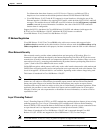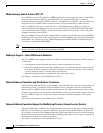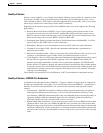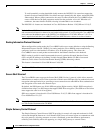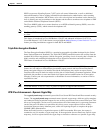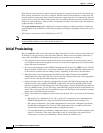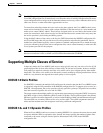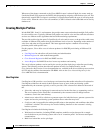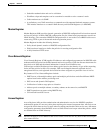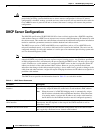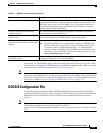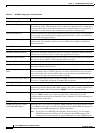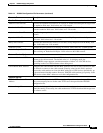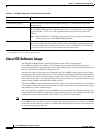
1-17
Cisco uBR924 Software Configuration Guide
OL-0337-05 (8/2002)
Chapter 1 Overview
Supporting Multiple Classes of Service
• Subscriber authentication and service validation
• Workflow scripts and templates can be customized as needed to suit a customer’s needs
• Cable modem reset via SNMP
• A preliminary set of NAS extensions to communicate with supported backend customer systems.
This includes interfaces to a central LDAP directory and Network Registrar (via NRCMD).
Modem Registrar
Modem Registrar (MR) provides dynamic generation of DOCSIS configuration files based on network
and service policies. It builds DOCSIS configuration files for clients based on parameters stored in an
LDAP directory. The customized DOCSIS configuration file is sent to the Cisco uBR924 cable access
router using TFTP as part of the normal modem registration process.
Modem Registrar includes the following features:
• Policy based dynamic creation of DOCSIS configuration files
• Web-based user interface to define the policies for creating configuration files
• A fully functional TFTP server
Cisco Network Registrar
Cisco Network Registrar (CNR) supplies IP addresses and configuration parameters for DOCSIS cable
modems and PCs based on user-defined network and service policies. CNR also allocates host names for
these devices in DNS and the related information is stored in an LDAP directory.
CNR assigns available IP addresses from address pools based on the identity or type of the requesting
device and the policies in effect. For example, CNR can distinguish between registered devices,
unregistered devices, and registered devices that have been assigned to a particular class of service.
Key features of Cisco Network Registrar include:
• DHCP server, with multiple address pools and multiple policies that can define different DHCP
options based on the address pool being used
• DNS server and dynamic DNS updates
• Verification of address usage prior to allocation
• Address pools on multiple subnets, secondary subnets on the same wire, and BOOTP
• DHCP operation over routers using BOOTP relay
• CLI and web-based GUI access
Access Registrar
Access Registrar (AR) provides authorization and authentication services for DOCSIS-compliant
modems that operate in a one-way cable plant requiring telco-return for upstream data. AR services can
also provide dial-in data services for users who are roaming outside their cable service area. AR returns
configuration parameters from RADIUS servers to NAS clients based on per-subscriber policies, which
are obtained from an LDAP directory.
Note AR does not apply to Cisco uBR924 cable access routers, which are two-way devices that do not require
telco-return services.



